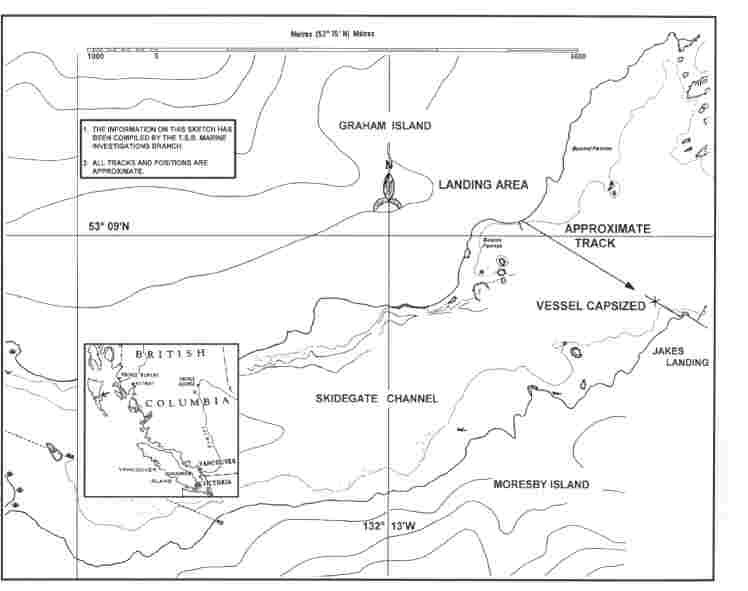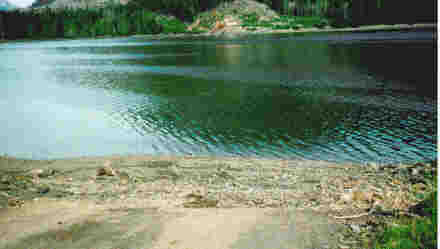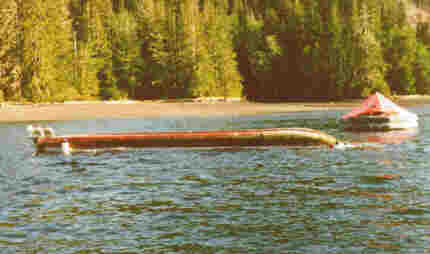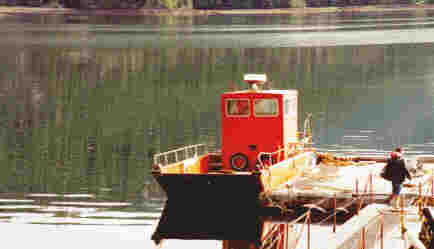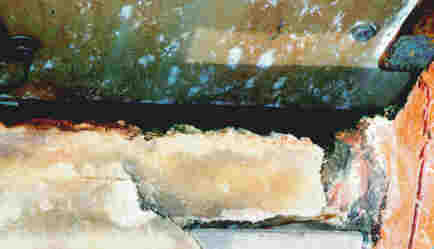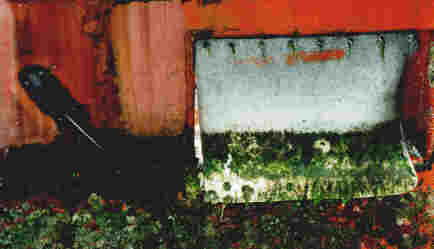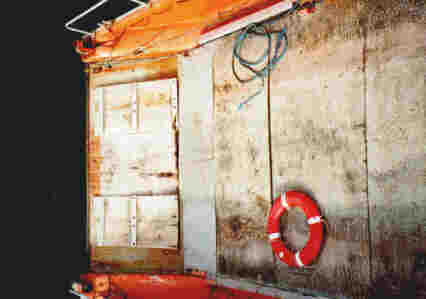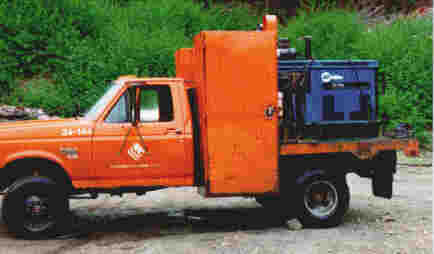Capsizing
Landing Craft "CROWN FOREST 72-68"
Queen Charlotte Islands,
British Columbia
The Transportation Safety Board of Canada (TSB) investigated this occurrence for the purpose of advancing transportation safety. It is not the function of the Board to assign fault or determine civil or criminal liability. This report is not created for use in the context of legal, disciplinary or other proceedings. See Ownership and use of content. Masculine pronouns and position titles may be used to signify all genders to comply with the Canadian Transportation Accident Investigation and Safety Board Act (S.C. 1989, c. 3).
Summary
While crossing Skidegate Narrows, British Columbia, the "CROWN FOREST 72-68" listed to starboard until the vessel capsized. The crew of two was in the wheel-house. The operator escaped from the wheel-house and climbed on the capsized hull. He was unable to find his companion after a search above and below water. The operator was rescued a short time later. The body of the missing crew member was later recovered from the wheel-house by a diver but resuscitation attempts were unsuccessful.
The Board determined that the vessel capsized because of a loss of initial transverse stability due to the free-surface effect of water accumulating on deck. The water accumulation was caused primarily by the deteriorated condition of the bow ramp seal. The fact that the vessel's operators and managers were not sufficiently knowledgeable to recognize that the ineffective ramp/hull seal seriously compromised the vessel's stability, and that no action was taken on unsafe condition reports made by the vessel's operators following previous near-capsizings contributed to this accident.
1.0 Factual Information
1.1 Particulars of the Vessel
| Name | "CROWN FOREST 72-68" |
|---|---|
| Official | Number 392962 |
| Port of registry | Vancouver, B.C.Footnote 1 |
| Flag | Canadian |
| Type | Fibreglass, general-purpose, cargo landing craft |
| Gross Tons Footnote 2 | 7.97 (22.56 m³) |
| Cargo | One vehicle, approximate weight of 5.3 tonnes |
| Length | 11.28 m |
| Breadth | 3.54 m |
| Draught | 0.4 m |
| Built | 1979, Versatile Cornat Industries Ltd., North Vancouver, B.C. |
| Propulsion | Twin Volvo six-cylinder turbo-charged diesels, inboard-outboard |
| Port Engine | 200 HP |
| Starboard Engine | 165 HP |
| Owners | Elk Falls Forest Industries, Vancouver, B.C. |
| Operators | Fletcher Challenge Canada, Sandspit, B.C. |
1.1.1 Description of the Vessel
The "CROWN FOREST 72-68" is a single-deck, shallow-draught fibreglass landing craft (see Appendix B). The engines are bridge-controlled. The hull is of box-frame construction fitted with polyurethane foam buoyancy. Two hinged freeing ports, measuring 406 mm wide by 229 mm high, are on each side of the transom.
The vessel was purchased new in 1979 and has since seen service in various divisions of Fletcher Challenge Canada around British Columbia. It has been in the Sandspit Division for about four years.
1.1.2 Description of the Bow Ramp and Gasket
The junction of the ramp and the hull section was fitted with a 38 mm-diameter flexible gasket to maintain the watertight integrity of the loading deck (see Appendix B). The gasket had deteriorated due to traffic and contact with sand, gravel and rocks when loading and unloading. No one could recall when the bow ramp seal was last intact as water was regularly shipped on deck when the vessel was loaded.
The original bow ramp was replaced by a stronger, aluminium-reinforced unit during the winter of 1991-1992. The gasket was not replaced when the ramp was renewed.
1.1.3 Variations from the Manufacturer's Standard Design
The vessel was ordered from the manufacturer with optional twin-diesel engines which are heavier than the standard gasoline-powered units, a larger wheel-house, deck sheathing and attachments. Fibreglass wear surfaces were added to the outer lower hull in way of the beaching area. These sponson protection "shoes" were not mounted fair with the hull. Large after metal brackets and bracing were also added to protect the stern drive units.
Other equipment was added mostly aft of midships. This caused the vessel to trim by the stern to such an extent that the scuppers were about 70 mm underwater in the light fully fuelled condition. This caused water to enter the scuppers on the port and starboard sides at the after end of the loading deck.
1.2 History of the Voyage
The landing craft is used to transport equipment between the beach at Jakes Landing on Moresby Island, B.C., and East Narrows on Graham Island, B.C., a distance of 850 m (see Appendix A).
On the morning of 15 May 1993, after the normal pre-start and operational checks, the vessel made two ferrying trips to East Narrows. Two maintenance vehicles were transported: a wash truck (two-wheel-drive vehicle), and a field (welding, etc.) truck (four-wheel-drive vehicle). The crew of the vessel consisted of the drivers of the trucks, two mechanics assigned to maintenance duties on Graham Island.
At about 1700Footnote 3, the mechanics returned to the landing craft with their vehicles. Upon satisfactory completion of vessel checks, the wash truck was ferried across. The vessel returned to Graham Island. The field truck was then driven on the landing craft, its parking brake was set and its transmission put in gear. The ramp was hoisted and secured with its safety chains as the vessel backed and turned.
The vessel proceeded toward Jakes Landing. Both mechanics were in the wheel-house. The wheel-house starboard door which was the nearest to the steering position was latched open.
About 100 m from Jakes Landing, the operator noticed that the vessel was listing to starboard. Water had accumulated on the starboard side of the loading deck.
The operator advanced the throttle levers from the 7/8 ahead position (approximately) to maximum. Although the engines responded, the vessel seemed to slow and the list increased. The operator then placed the throttles to neutral. The vessel's list to starboard increased as did her trim by the starboard bow when the water on deck surged forward. The starboard bow continued to go down until the field truck slid forward to the starboard bow and fell overboard.
Believing that the vessel would right herself once the vehicle had fallen overboard, the crew remained in the wheel-house; however, the vessel settled by the stern and capsized to starboard.
1.2.1 Abandonment of the Vessel
Because the vessel capsized so quickly, no distress call was made on the private channel radio in the wheel-house.
The operator exited the wheel-house by opening the door on the port side. He climbed on the hull and shouted to and looked for his partner. He saw the floating liferaft canister and pulled on the liferaft painter. He was surprised by the amount of painter he had to pull out, as he had expected the liferaft to inflate almost immediately.
Once the liferaft inflated properly in the upright position, the operator boarded. He opened the survival pack and ignited a hand-held red flare. The flare did not appear to burn with sufficient intensity to attract attention. The operator did not recognize the parachute flares in the survival pack canister.
The operator returned to the capsized landing craft, again shouting to and searching for his partner. He also dived into the water in an unsuccessful attempt to locate him.
The operator stayed on the capsized hull as he judged that the current was too strong to swim ashore. He noted that the time was 1715.
1.2.2 Search and Rescue
Seeing the orange canopy of the liferaft, two local sport fishermen in a small runabout arrived at the scene at about 1730. The survivor explained to them what had happened. As the fishermen's boat did not have a radio, the survivor asked one of the fishermen to go ashore to call for assistance from the company radio in the vehicle ashore at Jakes Landing.
The company emergency call of "99" was heard at about 1740 at the maintenance shed at Sandspit. Personnel answering the call concluded, from the information given, that the accident was in the vicinity of Jakes Landing. They were unsure of the details of the situation as the caller had cut short his call to return to the survivor on the inverted hull.
Access to the site is by a rough, twisting, animal-crossed, mountainous and unpaved logging road, requiring moderate speed and caution under normal conditions. The company emergency plan was put into effect as the ambulance, the helicopter, the Royal Canadian Mounted Police (RCMP) and company safety personnel responded. The helicopter was the first unit to arrive at Jakes Landing at 1812. The survivor and his rescuers were ashore in the truck.
After initial assessment, the helicopter was dispatched to fetch two divers from Sandspit. The ambulance arrived at 1830 and the survivor was treated. The helicopter returned at 1838 with two divers, one of whom recovered the body from the wheel-house. Cardiopulmonary resuscitation (CPR) was begun but, after some time, no response was seen and efforts were stopped.
Two out-of-province doctors were on a charter boating trip in the area and went to the scene. They reviewed the treatment given, checked vital signs and confirmed the decision to stop CPR. The body was flown to the hospital.
As the survivor did not wish to go to the hospital, he was released after treatment on the scene.
1.3 Injuries to Persons
One of the two members of the crew drowned.
1.4 Damage
1.4.1 Damage to the Vessel
The vessel's electrical equipment and both engines were immersed in sea water until the vessel was righted. Superficial damage was caused by lifting wires during the righting attempts.
1.4.2 Environmental Damage
An unknown quantity of diesel fuel was seen on the surface but it dissipated quickly with the wind and tide.
1.4.3 Other Damage
The field truck was recovered from 22 m of water and was refurbished.
1.5 Certification
1.5.1 Vessel
The vessel is less than 15 gross tons and is not certificated to carry passengers. There is no regulatory requirement for the submission of stability data to the Ship Safety Branch of the Canadian Coast Guard (CCG), and the vessel does not have to be inspected by the CCG Ship Safety Branch.
As the vessel was not certificated to carry passengers, the Industrial Health and Safety Regulations of the Workers' Compensation Board of British Columbia (W.C.B. of B.C.) did not apply.
1.5.2 Personnel Certification
Both persons involved in this occurrence had certificates as Master of a Small Craft issued on 29 April 1993 at Prince Rupert, B.C. The certificates included a restriction that the holder was "not to engage in towing operations, and operate only in Skidegate Channel between Kwuna Pt and Tcenakun Pt." Both operators refused to endorse their certificates as they believed that they had received insufficient training and instruction to operate the vessel.
The certificates were valid for the "CROWN FOREST 72-60", a crew boat used to transport workers between Graham Island and Moresby Island. Certification is not required to operate the "CROWN FOREST 72-68".
Many employees, who were expected to operate the vessel in the normal course of their employment, had also been examined for the same certificate.
Unlike certificates of competency of a higher grade, a Master of a Small Craft certificate does not require that the candidate receive mandatory marine training in liferaft deployment and operation, survival and rescue, fire-fighting, and cargo loading and stability.
1.6 Personal History - Operator
The operator's main job with Fletcher Challenge Canada (the company) was as a heavy-duty equipment mechanic. The operation of the "CROWN FOREST 72-68" was seen as just another means to move equipment and parts to a remote job site.
The operator had previous sea experience on fishing boats. He had operated the vessel on a regular basis in all weather and sea conditions for the past four years.
In his first year, with a more experienced operator at the controls, the laden vessel was near the shore when she began to list to starboard. Full throttle was applied and the vessel was beached at full speed.
1.7 Fitness for Duty - Personnel
Both men were fit and rested for their duties on this day. No drugs or alcohol were involved. There was no pressure to "get the job done"; it was an "overtime" maintenance day.
1.8 Training in the Operation of the Landing Craft
The company does not provide a structured training course for this craft. Both men involved in this occurrence were journeyman heavy-duty mechanics, not seafarers.
In the past, a designated operator had been in charge of the vessel. At the time of the occurrence, this was no longer the case; many employees operated the vessel. Most new operators observed and asked job-specific questions of the more experienced, or learned by themselves through on-the-job experience.
1.9 Operating Practices
The operator had never seen the vessel's operating manual; it was not on board nor could it be found in any of the company offices ashore. He did not fully appreciate the detrimental effect of free-surface water on the deck or that the vessel's watertight integrity was seriously compromised by the poor condition of the bow ramp seals.
Nearly all the operators of the vessel accepted as normal that water would come aboard through the gap between the deck and the ramp when the craft was loaded. This had happened on the three crossings made before the occurrence.
After the occurrence, a manufacturer's advertising brochure was found in the company offices. It provided "standard" payload, freeboard, weights and other general information.
At some time before the occurrence, the company had posted a memo on the after bulkhead of the wheel-house giving some guidance on maximum loads. It stated:
Maximum safe load capacity is 5 tons. (short)
Maximum load with passengers aboard will be 3 tons.(short)
After the capsizing, Fletcher Challenge Canada determined that the weight of the vehicle was 5.8 short tons (5.3 tonnes).
The gross weight of the vehicles transported was not indicated on the vehicles.
The craft was loaded according to the individual operator's past experience and the collective experience of other operators with whom he had consulted.
The operators' prime concern seemed to be whether the vehicle was a two- or four-wheel drive. Two-wheel-drive vehicles were backed on to the vessel to ensure they had adequate traction and speed for traversing the soft foreshore upon discharge. Four- wheel-drive vehicles were driven on front first as departure traction was usually not a consideration.
One experienced operator felt that the craft handled better when the field truck was backed on. This may have affected the vessel's trim; however, regardless of the direction in which the truck was loaded, the water still came on board because of the lack of a ramp seal.
1.10 Previous Similar Occurrences
This was not an isolated occurrence. Other operators, past and present, reported to Fletcher Challenge Canada that water had accumulated on deck and that the vessel had developed a sudden list, always to starboard, when the vessel was laden. The ramp was either up or down when this happened.
On these previous occasions, the nearness of the shore, rapid application of full throttle, the resultant hard beaching and a measure of good fortune appear to have prevented these similar occurrences from becoming tragedies.
1.11 Trim and Running Trials
On 21 September 1993, trials were conducted to verify the source and the extent of sea water ingress on the loading deck. The loading ramp flexible seal was in the same condition as it was at the time of the capsizing. The load carried on the loading deck was reduced to ensure that the conditions which led to the capsizing were not repeated.
In normal service, the main engines turn at a maximum of approximately 2,610 RPM. The propeller thrust can be adjusted plus or minus five degrees from the horizontal to influence the vessel's trim at various loads when accelerating or maintaining various speeds.
At both propeller drive angle settings, running trials were conducted at 1,000, 1,500, 2,000 and 2,500 RPM. The trim, the corresponding bow wave profile and the ingress and the extent of the water retained on deck were monitored.
At the initial trial speed, only light spray was shipped. As speed was increased, the forward and after trim showed little significant change at either of the propeller drive trim settings.
The height of the bow wave and the rate of ingress of sea water progressively increased as the trial speed was raised.
At 2,500 RPM, the height of the consistent bow wave was approximately 150 mm above the forward end of the loading deck and its related spray level was about 460 mm higher. Sea water was continuously shipped through the gap in way of the damaged seal. Water covered the entire loading deck from the base of the ramp to the front of the wheel-house. The retained sea water was about 40 mm deep at the forward end of the loading deck and 20 mm deep at the front of the wheel-house. It was 50 mm deep where it flowed aft in the port and starboard side scupper channels before discharging through the transom freeing ports.
The shipped water retained on the loading deck during the trials created a large free- surface effect which markedly reduced the initial transverse stability of the lightly loaded vessel. The situation would have been much worse in normal service with the truck loaded on the loading deck. The vessel would have been deeper in the water, the rate of ingress and the amount of water retained on the loading deck would have been greater and the vessel's centre of gravity would also have been higher.
1.12 Stability and Inclining Experiment
The design of the vessel is such that the integrity of the hull is dependent on the boundary of the raised loading ramp being maintained watertight by flexible compression seals. These seals maintain the effective freeboard and reserve buoyancy level with the top of the bulwark rail and also maintain the "intact" transverse stability.
The hull construction incorporates a volume of rigid polystyrene foam below the loading deck which provides sufficient reserve buoyancy to prevent the vessel from sinking in the event of swamping or flooding. The foam is not specifically intended to augment the vessel's righting ability or to prevent capsizing.
The capsized vessel floated without a list or an abnormal trim, indicating that the hull itself was not breached. After the occurrence, holes were drilled in the dry-docked hull bottom at various locations to detect if water had been absorbed by the flotation material. No significant amount of water was found.
On 21 September 1993, the owners conducted an inclining experiment to determine the vessel's lightship characteristics and stability in various loading conditions. The experiment was conducted by an independent naval architect. A TSB naval architect also observed and his calculations have been incorporated in this report.
Calculations show that, with the loading ramp properly sealed and the truck located symmetrically about the fore and aft centre line, the fully loaded vessel has a relatively large metacentric height (GMt) of 1.83 m, a positive range of statical stability of 68°, and "intact" forward and after effective freeboards of 0.85 m and 0.74 m respectively.
These characteristics relate to "intact" stability; however, the bulwark rail is immersed at an angle of about 24° of heel. The resultant sudden downflooding would subject the vessel to dynamic rolling effects, before the calculated maximum static angle is attained.
Further calculations, incorporating the same deck loading as above, addressed the detrimental effects of the damage to the loading ramp seals on the vessel's initial stability.
The static trim of the vessel is such that the freeboard to the loading deck at the base of the loading ramp is approximately 25 mm. The running trials showed that the top of the vessel's bow wave was consistently above that level. Consequently, the loss of watertight integrity caused by the damaged loading ramp seals allowed sea water to be shipped and retained on the loading deck. The quantity of water shipped is unknown; however, a nominal layer of water 50 mm deep on the loading deck has been incorporated in the calculations to assess the "damaged" stability.
The free-surface effect of the shipped water would virtually eliminate the vessel's initial transverse stability. The GMt would be reduced to approximately 0.05 m. With the vessel in this highly vulnerable condition, a relatively minor athwartships moment or external force could cause a large angle of heel to develop suddenly.
The effects on intact transverse stability caused by the athwartships movement of the field truck were also addressed. Calculations show that, with the truck on the starboard side of the loading deck adjacent to the inboard side of the bulwark rail, the vessel would maintain a permanent static heel of approximately six degrees. In this condition, the remaining "intact" dynamic stability would be only 55 per cent of that when the vessel was upright.
It should also be noted that, with the vessel heeled six degrees to starboard in static conditions, the forward outboard corner of the loading deck in way of the loading ramp seals would be submerged about 125 mm. The result of the damage to the seal would be that sea water would be shipped continuously and retained on the loading deck.
The calculations also addressed the effect on transverse stability of the shipping and retention of sea water on the loading deck in conjunction with the athwartships movement of the truck.
The free-surface and heeling effects of the 50 mm nominal layer of shipped sea water, when gravitated six degrees to starboard due to an athwartships shift of the field truck, would induce a heel of approximately 11°. Only 21 per cent of the vessel's original dynamic stability (up to the immersion of the bulwark rail) would be retained.
Because the induced heel of 11° exceeded the gravitated angle, the damaged loading ramp seals were more deeply immersed and sea water would continue to be shipped on the starboard side of the loading deck. The angle of heel would increase steadily until the reaction of the truck was transferred from the loading deck to the top of the bulwark rail. The dynamic effect caused the vessel to lose transverse stability and capsize suddenly.
1.13 Weather and Tidal Information
1.13.1 Weather
Those on board were not required to record the weather; however, it was reported by many on the scene that the wind was light and the sea rippled; it was partly cloudy and the air temperature was about 14°C.
The nearest meteorological recording station to the scene of the capsizing is at Sandspit, 15 nautical miles (M) due east. At 1800, the weather recorded at Sandspit was south-east winds at 17 knots, scattered cloud and an air temperature of 12°C.
The weather observed and recorded did not differ significantly from that forecast for the area.
1.13.2 Tide
Low water at Queen Charlotte City (8 M from the occurrence site) was at about 1630 on 15 May. Canadian Hydrographic Service (CHS) chart No. 3891 states that "Slack water at East Beacon (1 M west of occurrence site) occurs about 1.5 to 2.5 hours after high or low water at Queen Charlotte City." At the occurrence site, slack water could be expected between 1800 and 1900.
1.14 Industrial Health and Safety Considerations
The employees believed that the safety of the vessel was regulated. In fact, CCG regulations applied to only parts of the vessel and her equipment.
Section 28.14 to Section 28.20 of the W.C.B. of B.C. Industrial Health & Safety Regulations, which refer to Marine Craft, have the following caveat: "All marine craft used for the transportation of workers are governed by the "Canada Shipping Act" (CSA) and regulations pursuant thereto."
This vessel was used to transport equipment across the narrows. A separate crew boat was to be used for personnel. In practice, the landing craft was more convenient and expedient to use and became the vessel of choice for passengers.
The incidents referred to previously in the report were reported verbally to supervisors for action. No written report of the incidents were made. There is no written record of the verbal reports made in safety meeting minutes held before the occurrence.
Section 8 of the Industrial Health & Safety Regulations, "Places of Employment- General Requirements", "Correction of unsafe conditions" (Section 8.10), requires that: "... the person receiving the report shall investigate the reported unsafe condition or act and shall ensure that any necessary corrective action is taken without delay."
No action was taken to replace the ramp/hull seal as a result of these verbal reports.
1.15 Radio Communications
There is no regulatory requirement that a marine very high frequency (VHF) radio be fitted on this size and class of vessel.
The VHF radio fitted on the "CROWN FOREST 72-68" is licensed for land use only and uses the private frequencies of Fletcher Challenge Canada. To ensure communications reliability in this mountainous area, the company maintains radio repeater stations.
The mechanics made routine radio calls during the day. The radio equipment operated satisfactorily until the vessel capsized.
The initial call for assistance was made on a company frequency from a truck radio ashore.
1.16 Life-saving Equipment
The vessel carried the life-saving equipment (LSE) required by regulations. The crew was wearing vest-type personal flotation devices.
A float-free Emergency Position Indicating Radio Beacon (EPIRB) is not a regulatory requirement for the vessel. None was carried.
Although it was not a regulatory requirement, a 20-person inflatable liferaft was carried. Equipment included a "B" survival pack containing hand-held and parachute flares. The liferaft was due for inspection on 28 January 1993.
After the occurrence, the liferaft was serviced and repacked at the same approved depot where it had last been inspected. It was found to be in good condition.
2.0 Analysis
2.1 Operators - Level of Training
Skilled, proficient and knowledgeable operators are necessary to operate machinery safely. Personnel were not allowed to operate land-based equipment or machinery unless they were certificated after satisfactory completion of approved training courses. The vessel differed from other equipment in that respect even though she also had to be operated safely.
Although the operator had several years of experience in operating the vessel and some background in commercial fishing, his level of training and knowledge was not adequate to recognize the inherent dangers of operating the vessel with free-surface water on the deck. The same was true of the vessel's other operators.
The operators had reported the tendency of the vessel to capsize before this accident, but no action was taken by their employer to rectify the situation. This indicates that either the management of the company did not have the level of expertise necessary to recognize the dangers of operating the vessel in such a condition or chose to ignore them.
Because the vessel's operating manual had been misplaced ashore, vital information on safe working practices was not available to the vessel's management or operators. The manual outlines the safe working practices necessary to avert such an accident.
2.2 Bow Ramp Seal
A flexible gasket is required to maintain the watertight integrity of the bow ramp. Without the flexible seal, the effective freeboard of the vessel is at the same level as the deck; in this case, there was no effective freeboard at all when the vessel was loaded. The operating manual stresses the importance of bow ramp gasket integrity; however, Fletcher Challenge Canada was not aware of and did not ensure that the vessel's operators were aware of the gasket's importance.
2.3 Effect of Adding the Sponson Protection Shoes
The addition of the fibreglass wear surfaces to the outer lower hull in way of the beaching area aggravated the lack of freeboard because the shoes were not mounted fair with the hull. The shoes would thus increase the size of the bow wave and force more water through the ramp/hull gap. The shoes added weight to the forepart of the vessel and also acted as water scoops which prevented the bow from lifting when making headway. The drag on the vessel would have increased considerably and generally degraded loaded-condition performance.
2.4 Propensity to List to Starboard
The reasons for the vessel's tendency to always list to starboard when water was on deck were not readily apparent. The underwater portion of the hull is clear of any obstruction that may cause this. The hull is not deformed, racked or twisted in a way that would produce this tendency. Some possible reasons are advanced below.
- The sponson protection shoes attached to the hull are not fair with the hull and exhibit different degrees of damage as a result of beachings. While it is not easily measurable, it is possible that the drag caused by the starboard shoe could be greater than that of the one to port, thereby giving a turning moment to the hull.
- The tube socket fitting on the starboard inboard bulwark is secured to an internal hull box member for strength. This attachment area is reinforced and intrudes into the water channel that allows drainage aft of any water on deck. The anchor rope is coiled down in the channel as well. The channel is not blocked completely as a drainage slot exists to allow small quantities of water to pass through. However, this arrangement was never designed to pass the large amount of water that came through the ramp gap. The resulting accumulation of water trying to pass through and around this area would cause a list and the resultant free-surface effect would reduce the vessel's stability. The added weight would also cause bodily sinkage, putting the bow, and therefore the gap, further under water and forcing more water on to the deck.
Separately, the above factors may not be significant, yet their synergism may exceed the sum of their individual effects.
2.5 Industrial Health and Safety Considerations
Contrary to what the employees believed, the CSA applied to the vessel only in respect of the carriage of LSE and to the lights that the vessel was required to carry. The vessel met or exceeded these requirements; however, due to her small tonnage, there was no requirement that the vessel be inspected by the CCG Ship Safety Branch.
2.6 Vehicle Weights
No explanation was given why the weights of the vehicles to be carried by the vessel were not determined and prominently displayed on the vehicles. The company was aware of the maximum weight to be carried on the vessel and had posted this weight in the wheel-house before the occurrence.
2.7 Familiarity with Life-saving Equipment
The operator was not required to have formal marine emergencies training. The difficulties he experienced with the LSE could have had serious consequences. The operator did not recognize the parachute flares in the liferaft canister. As a result, he did not use the best means of attracting attention.
2.8 Safety Culture
Logging is one of the most dangerous industries in British Columbia. Over the last 15 years, there have been almost 500 fatalities, and over 4,700 loggers have been awarded permanent disability compensation. As a result, the industry has developed programs to address safety issues and reduce the accident rate.
These safety programs were, however, not extended to the operation of the landing craft. There was no designated operator, no formal training, and no response to equipment and operational deficiencies. There was also a lack of understanding of the applicability of regulatory standards and a failure to recognize the inherent dangers of operating the vessel.
The safety system in place was either not working or failed to appreciate the marine aspects at this logging operation.
3.0 Findings
- The damaged and ineffective ramp/hull seal allowed water on deck and reduced the vessel's effective freeboard to the same level as the deck.
- The vessel's initial transverse stability was reduced by the free-surface effect of the water on deck.
- The vessel had significant weight added aft as a result of changes to the original design.
- When the vessel was not carrying cargo, the freeing ports aft were partly underwater and allowed water on deck.
- The vessel had nearly capsized on several occasions before this occurrence.
- The vessel's operators and managers were not sufficiently knowledgeable to recognize that the effect of allowing the vessel to operate with a damaged ramp/hull seal was to seriously compromise the vessel's stability.
- The vessel's operations manual was not made available to the operators or their immediate supervisors.
- None of the operators were required to have formal marine emergencies training.
- Supervisory personnel did not act on unsafe condition reports by the vessel's operators stating that the vessel had a tendency to list suddenly when water was on deck.
- The weight of the vehicle on board at the time of the occurrence was approximately 0.3 tonne more than the maximum weight recommended by published company policy.
- The weight of the vehicles transported on the day of the occurrence was not displayed on the vehicles nor was the weight of the vehicles accurately known.
- Vehicles were not secured to the deck because of the short travel distance involved.
- Although not licensed to do so, the vessel was used to transport personnel.
3.1 Causes and contributing factors
The vessel capsized because of a loss of initial transverse stability due to the free-surface effect of water accumulating on deck. The water accumulation was caused primarily by the deteriorated condition of the bow ramp seal. The fact that the vessel's operators and managers were not sufficiently knowledgeable to recognize that the ineffective ramp/hull seal seriously compromised the vessel's stability, and that no action was taken on unsafe condition reports made by the vessel's operators following previous near-capsizings contributed to this accident.
4.0 Safety Action
4.1 Safety Action Taken
4.1.1 Seaworthiness
In 1993, as a result of this occurrence, an independent naval architect conducted an inclining experiment on the vessel on behalf of the owners. The TSB also conducted running trials and evaluated the results of the inclining experiment. The Canadian Coast Guard (CCG) and the vessel owners were apprised of the poor physical condition of the gasket material forming the watertight joint between the ramp and the hull of the landing craft, and of the adverse consequence that the accumulation and free movement of water on the loading deck may have on the vessel's effective freeboard and transverse stability. The "CROWN FOREST 72-68" was subsequently taken out of service.
4.1.2 Additional Follow-on Actions
Subsequent to a Coroner's inquest on this accident, the owners of the "CROWN FOREST 72-68" indicated that the following safety measures had been taken:
- The company safety committee tours the vessels in use every month to identify safety concerns and deficiencies;
- The International Woodworkers of Canada and Forest Industrial Relations Members Companies have signed an agreement to establish a Joint Committee to develop procedures, equipment standards, and training for the operation of crew boats and barges carrying less than 12 passengers;
- Emergency procedures have been reviewed with respect to radio communication, requests for diver assistance, and first aid in the workplace;
- Management and operational personnel within the company, as well as other operators who have purchased similar craft from the company, have been made aware of the potential conditions leading to vessel instability; and
- The "CROWN FOREST 72-68" was taken out of service and the replacement barge was upgraded to meet CCG stability standards. Typical loading information for large and small equipment was also provided.
4.1.3 Safe Working Practices
In 1993, the Workers' Compensation Board of British Columbia (W.C.B. of B.C.) published a poster (Logging 93-08) to advise workers in the logging industry of the dangers associated with the operation of small landing craft. The poster calls for the employer to provide written procedures on safe work practices for workers under their direction and control, and to ensure that machinery and equipment are safe. It also reminds workers that a special inspection must be made when there is a malfunction of machinery or equipment.
4.1.4 Marine Emergency Duties (MED) Training
The TSB brought the need for training in the use of life-saving equipment on board vessels to the attention of the CCG and of the owners of the "CROWN FOREST 72-68". The CCG regional office was notified to advise the owners of the landing craft of the content of Ship Safety Bulletin (SSB) No. 10/88 which, inter alia, strongly recommends that all members of the ship's crew complete the Basic Safety Course, Level A1, MED training.
In February 1995, in its SSB No. 6/95 on MED training, the CCG republished and updated issues dealing with MED training previously developed in 1988. The SSB provides general safety advice to industry respecting on-board safety familiarization training to prepare the crew for dealing with emergencies and to reinforce skills for those who have not received MED training.
The CCG has also indicated that, although current regulations do not require MED training for personnel of uninspected vessels, proposed amendments to the crewing regulations will require basic MED training for all persons on ships over five gross tons. The responsibility for MED training of uncertificated personnel of vessels not covered by these regulations rests with the owners and masters of these vessels.
4.2 Action Required
4.2.1 Operator Training and Operating Guidelines
Personnel operating the "CROWN FOREST 72-68" reported that water was regularly seen on deck when the vessel was under way, and that the vessel had developed a starboard list when water was on deck. No one could recall when the bow seal was last intact. The vessel's operators and managers were not sufficiently knowledgeable about vessel stability to recognize that having water on the deck constituted a serious hazard.
Small landing craft used to ferry machinery and vehicles, like the "CROWN FOREST 72-68", are not regulated or required to be inspected under the Canada Shipping Act (CSA). Furthermore, there are no training and certification requirements for personnel to operate such craft. In the case of the "CROWN FOREST 72-68", trained personnel with a knowledge of the vessel's stability and of free-surface effect would have been able to recognize the risks associated with operating the craft under such conditions.
Reportedly, there are more than 70 similar small landing craft being used on the West Coast of Canada, many of these in remote areas where emergency assistance may be limited. Furthermore, the craft are most likely being operated by personnel not formally trained in marine operations, including the deployment and use of life-saving equipment.
The Board recognizes the initiative taken by the Forest Industrial Relations Members Companies and the International Woodworkers of Canada to develop procedures and training for the operation of craft carrying less than 12 passengers. The Board applauds this action; yet, it feels that the training of personnel and the development of procedures for the handling of vessels should benefit from the input of experts in the marine discipline. The CCG has this expertise. Properly developed and implemented training and procedures could go a long way to enhancing safety in the operation of unregulated small craft, such as the "CROWN FOREST 72-68".
Furthermore, as evidenced by this occurrence, the owners/operators of unregulated craft may not be aware of conditions, such as the poor condition of the watertight seals, that could be potentially hazardous to the seaworthiness of these craft. The Board is concerned that despite efforts to enhance the knowledge and skills of the operators of these craft, a lack of proper procedures and guidelines on maintenance of both the craft and life-saving equipment could still jeopardize safety. Therefore, the Board recommends that:
The Department of Transport, in conjunction with small landing craft owners/operators, develop training programs and guidelines for the operation and maintenance of these craft.
Transportation Safety Recommendation M95-04
This report concludes the Transportation Safety Board's investigation into this occurrence. Consequently, the Board, consisting of Chairperson, John W. Stants, and members Zita Brunet and Hugh MacNeil, authorized the release of this report on .
Appendices
Appendix A - Sketch of the Area of the Occurrence
Appendix B - Photographs
Appendix C - Stability Calculations
Stability calculations were carried out and the results are available from the Transportation Safety Board of Canada upon request.
Appendix D - Glossary
- B.C.
- British Columbia
- C
- Celsius
- CCG
- Canadian Coast Guard
- CHS
- Canadian Hydrographic Service
- CPR
- cardiopulmonary resuscitation
- CSA
- Canada Shipping Act
- EPIRB
- Emergency Position Indicating Radio Beacon
- field truck
- A heavy-duty, four-wheel-drive, diesel truck designed to carry the welding, burning and special equipment necessary to maintain field machinery in remote areas.
- Free-surface effect
- Reduction of stability caused by the presence or movement of unrestricted liquid surfaces within a vessel.
- GMt
- Distance from the vertical centre of gravity (G) to between the transverse metacentre (M) which, when positive (i.e., G below M), is indicative of a vessel's initial stability.
- HP
- horse power
- IMO
- International Maritime Organization
- LSE
- life-saving equipment
- m
- metre(s)
- m³
- cubic metre(s)
- M
- nautical mile(s) (1,852 m)
- MED
- Marine Emergency Duties
- mm
- millimetre(s)
- PDT
- Pacific daylight time
- RCMP
- Royal Canadian Mounted Police
- RPM
- revolution(s) per minute
- short ton
- 2,000 pounds
- SI
- International System (of units)
- SSB
- Ship Safety Bulletin
- stability
- The ability or tendency of a vessel to remain or to return to the upright.
- tonne
- 1,000 kilograms (2,204.6 pounds)
- TSB
- Transportation Safety Board of Canada
- UTC
- Coordinated Universal Time
- VHF
- very high frequency
- wash truck
- A tank vehicle containing an alkaline washing solution used, under pressure, to clean field equipment before servicing.
- W.C.B. of B.C.
- Workers' Compensation Board of British Columbia
- 99
- A company-designated code for internal use on its private radio frequencies which indicates "a life-threatening emergency."
- °
- degree(s)
